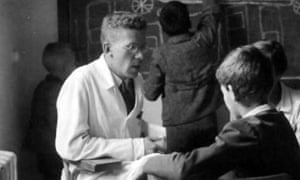The story that Hans Asperger saved autistic children from the Nazis is exposed as a myth in Edith Sheffer’s new biography
The caring image of Hans Asperger with young patients in his Vienna clinic circa 1940. Photograph: Alamy
What’s in a name? Ever since 1981, when the writing of Austrian paediatrician Hans Asperger was introduced to an English-language audience, autism professionals have embraced Asperger syndrome (AS) as a condition. It excludes the most debilitating intellectual, communication and physical difficulties associated with classic autism. Between 1994 and 2013, AS was an official diagnosis in the American psychiatric bible The Diagnostic and Statistical Manual of Mental Disorders and is still widely used internationally. But who was Hans Asperger and how did the medical establishment come to honour him?
Over the decades, a myth has evolved that Asperger, who worked in Vienna during the second world war, was akin to Oskar Schindler. He had talked up his young autistic patients’ potential in order to protect them not only from the legalised mass sterilisation of the “genetically unfit”, but also to prevent them from becoming victims of the more covert “euthanasia” T4 programme which led to the murder of over 300,000 disabled people. But now the American historian Edith Sheffer has systematically destroyed that persona in Asperger’s Children, a superbly researched account of his career. She has drawn on records recently discovered by the assiduous Austrian researcher Herwig Czech. These wartime documents reveal that, instead of saving children in his care, Asperger wrote wholly damning descriptions of at least 42 of his patients. His signature is on the paperwork that transferred them to the notorious Am Spiegelgrund clinic where almost 800 children died due to neglect or lethal overdoses. It would have been impossible for Asperger not to know his patients’ likely fate; the killings at the asylum led to public protests.
Sheffer reveals that Asperger actively endorsed the forced sterilisation laws
Sheffer also gives a long-overdue and gripping analysis of Asperger’s own writing before, during and after the Third Reich. She details his wartime denigration of the cognitively and physically disabled children in his care. She frames him as complicit in “negative eugenics” and a careerist. Jewish doctors were forbidden to practise public medicine during the Anschluss. While never a Nazi party member, Asperger did not protest about his more senior Jewish colleagues’ exclusion. Aged 28, he became the head of the Curative Education Clinic within Vienna’s prestigious children’s hospital. Sheffer writes: “In May 1938, Asperger began to work for the Nazi state as a psychiatric expert for the city’s juvenile court system. He also applied to consult for the Hitler Youth.”
Sheffer reveals that Asperger actively endorsed the forced sterilisation laws, citing his words that some people were “a burden on the community” and that “the proliferation of many of these types is undesirable for the Volk, ie, the task is to exclude certain people from reproduction”.
The pioneering British autism psychiatrist Lorna Wing did not know this history when she first came across Asperger’s writing in the late 1970s. She had been assessing young patients at the Maudsley psychiatric hospital in London. They did not fit into existing categories such as autism or schizophrenia because they had no obvious intellectual disabilities or delusions. However, their profound difficulties with obsessive thinking and social interaction meant that they still needed help, particularly as they were at high risk of depression.
Casting around for a diagnosis, Wing was attracted to Asperger’s writing on what he had called “autistic psychopathy” in the 1940s. His work had never been translated into English; Wing relied on her husband’s schoolboy knowledge of German for an initial translation of Asperger’s 1944 thesis.
She was impressed by the Austrian paediatrician’s detailed, sympathetic descriptions of his patients. They sounded just like the young men she was encountering at the Maudsley. There was a stigma around the word “autism” so Wing proposed a new diagnostic term, Asperger syndrome. She wrote that while autism was associated with “muteness and total social withdrawal”, for parents “the suggestion that their child may have an interesting condition called Asperger’s syndrome is more acceptable”.
Wing only met Asperger once, not long before he died in 1980. His strong belief that “curative education” could help appealed. As well as being a psychiatrist, she had a profoundly autistic daughter and shared Asperger’s view that appropriate education could improve outcome. Wing’s own thesis was that autism was a spectrum disorder and did not always entail intellectual disability and that variant could usefully be termed Asperger Syndrome. He became the ideal figurehead for the burgeoning autistic rights movement, which argues that autism is a difference to be accepted, rather than a disease to be prevented or cured.
The godfather of 1940s autism in America, child psychiatrist Leo Kanner was widely disliked for blaming poor parenting or “refrigerator mothers” for causing a debilitating disorder; Asperger maintained autism was inborn and could come with positive abilities.
It’s hard to believe that anyone will want to identify with Asperger syndrome after reading Sheffer’s extremely disturbing but very lucid book, but what should replace it? Wing syndrome, perhaps. Certainly it would honour a doctor who cared for all autistic people and worked tirelessly to make their lives better.
• Asperger’s Children by Edith Sheffer is published by W W Norton & Co (£20). To order a copy go to guardianbookshop.com or call 0330 333 6846. Free UK p&p over £10, online orders only. Phone orders min p&p of £1.99
from https://www.theguardian.com/books/2018/…
